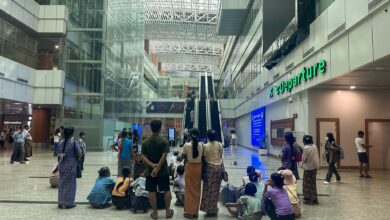
This article includes graphic images.
Peter Oo was just a normal teenager when the military seized power in February 2021. He grew up in Daw Ngan Khar, a village in Karenni (Kayah) State’s Demoso Township, and had dreams of going to university and working overseas someday.
He wasn’t extremely ambitious, however, so when Covid-19 stalled his education at the 10th grade, he took it in stride. But when the coup hit a year later, it was another matter. Like countless others around Myanmar, he protested. And when the regime responded with a brutal show of force, he joined the armed struggle to reclaim the country from its oppressors.
But it wasn’t until around a year later, on May 26, 2022, that his life changed forever.

During a battle near his home village, he heard a loud explosion that threw dirt into the air and uprooted a bush right in front of his eyes.
It also sent him flying. He landed face down, and only then did he realise that he had been hit. At first he thought it was a grenade.
Still lying in a prone position, he looked around to survey the situation. He saw one of his feet, completely severed from his leg, sitting on his backside. His calf muscles were torn and bleeding, and bones were jutting out of what was left of his two shattered legs.
“When I saw the bones sticking out like that, I knew it was a landmine. I didn’t know what to do. I just lay there. Then, when I started shouting, ‘Help me tie it, help me tie it,’ a friend came running towards me,” he recalled.
“My friend took out a towel and tied it around my thigh above my wound. I felt more comfortable then.”

‘Shoot me’
Peter Oo was just two weeks past his 19th birthday when he lost both of his legs while fighting troops from the military’s Demoso-based Infantry Battalion 102 and the notorious Light Infantry Division 66.
At an age when he should be studying and exploring his interests, he finds himself facing an uncertain future as a veteran of a war that shows no signs of ending. But he insists that he has no regrets.
“It’s okay that my legs are gone. There are many people without legs in the world. I tried to compose myself. I got my act together and I wasn’t sad anymore,” he says of his feelings.
Even in the immediate aftermath of the incident, he was uncannily dispassionate about what had happened to him. When his friend told him not to look at the mangled stumps where his legs had once been, he did anyway. He even asked his friend to film his wounds.

“He held me closely around the chest and told me not to look. But I sneaked a peak and saw the bones and the dangling, bloody flesh. I could see that both legs were in the same condition,” he said.
It was a half-hour walk to the car that would take him to the nearest clinic for treatment, and his friend had to carry him on his back. Peter was conscious the entire time, and it was only after they reached the vehicle that he suddenly grasped the enormity of the situation. The thought of becoming a burden to his parents became too much for him to bear.
“I had second thoughts once I was in the car. I asked my friend to shoot me dead. He was in tears, but he didn’t shoot me,” he said.
On the way to the clinic, his comrades told him not to close his eyes. They also tried to encourage him not to give, saying that there were still many things that he could do with his life.
An ongoing struggle
It took hours to reach the clinic. The medics examined him and said that his life was not in any danger, but that both legs would have to be amputated. The left leg, which had also suffered serious burns, would have to be cut off at the base of his thigh. The right leg was amputated below the knee.
He was still in pain six months after the incident, but over time, his wounds began to heal. And as his condition improved, he sought new ways to contribute to the revolution.
He is now learning how to use a computer so that he can perform administrative tasks. This includes writing press releases about the ongoing conflict, which sees almost daily clashes.
“I do what I can,” he says. “I can type up official statements and invitations to meetings. These things are needed at this time.”

A fellow member of the Demoso People’s Defence Force describes him as a positive person, friendly with his comrades and committed to his work. He is also one of four members of the group who have lost limbs in the fight against the regime.
He admits that he still gets depressed sometimes. But as the military continues to inflict untold suffering on local civilians, carrying out airstrikes and artillery attacks and burning down entire villages, he thinks of the battles he took part in against the junta’s soldiers and his spirits recover.
Like many thousands of others, Peter’s parents and the rest of his village’s inhabitants have been forced to flee to hilly areas near Karenni State’s border with Thailand for safety.
Despite the uncertainty that hangs over their lives, and the high price that he and many others have had to pay for opposing the regime, Peter remains convinced that it has all been worth it.
“I will continue to do as much as I can,” he says. “I don’t ask for anything. The main thing is to win the revolution as soon as possible, so we can have the freedom to live as we please.”

A video recording of Peter Oo soon after losing both of his legs (Supplied)



